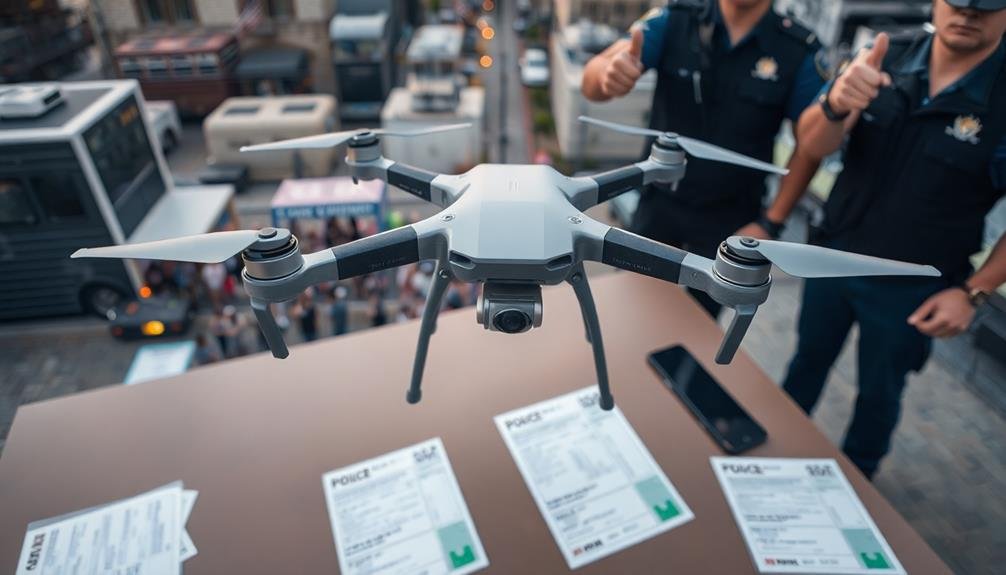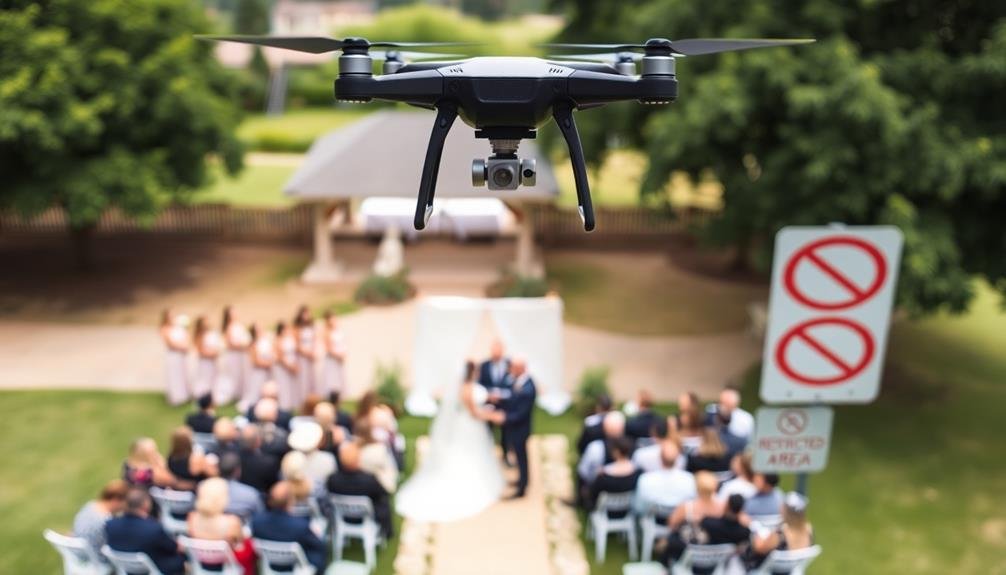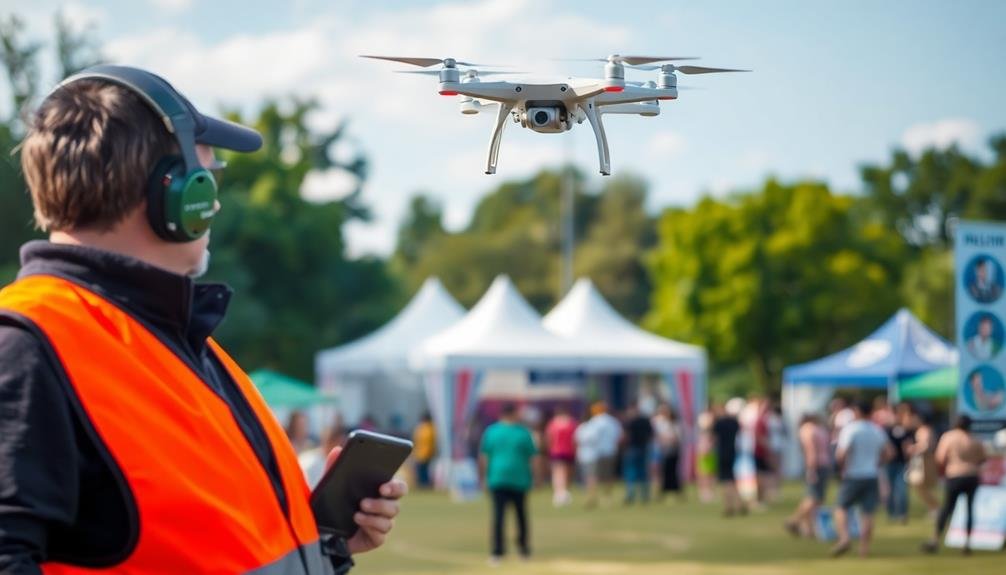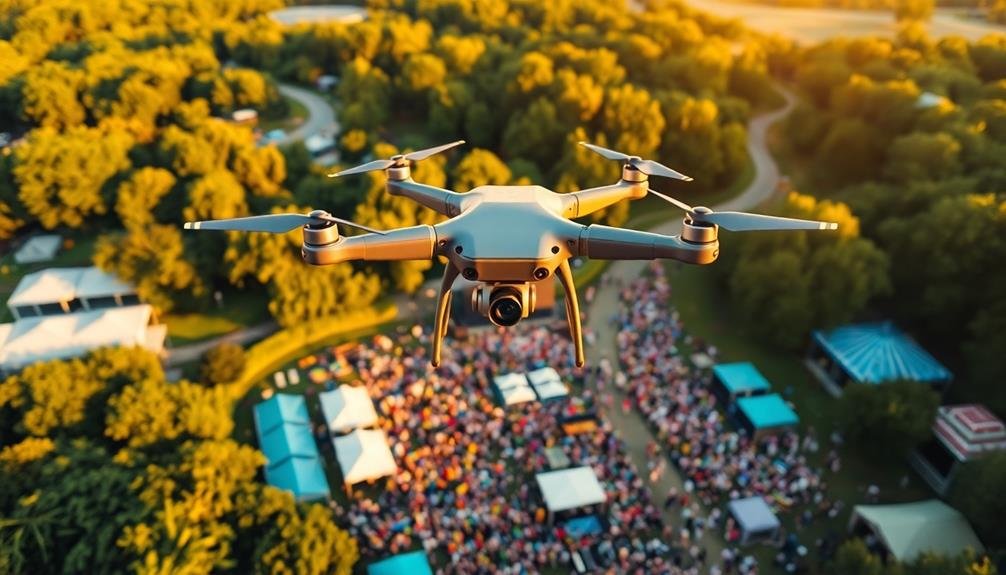When capturing aerial footage at events, you'll need to follow three essential rules. First, obtain all necessary permits, including FAA permissions and commercial drone licenses. Second, respect privacy by securing explicit consent before filming individuals or private property, and avoid crowded areas. Third, prioritize safety through thorough pre-flight checks, clear communication protocols, and the use of visual observers. Always adhere to no-fly zones and organizer guidelines to maintain professionalism. By mastering these key principles, you'll create stunning aerial photography while ensuring legal compliance and respecting attendees' privacy. Dive deeper to reveal the full potential of event drone photography.
Key Takeaways
- Obtain necessary permits, including FAA clearance and property owner consent, before conducting aerial photography.
- Respect privacy by avoiding close-ups of individuals and adhering to no-fly zones at events.
- Prioritize safety with thorough equipment checks and clear communication protocols during flights.
- Focus on capturing wide-angle views to showcase the event atmosphere without invading personal space.
- Ensure compliance with Part 107 regulations for commercial drone operations at events.
Obtain Necessary Permits

Always obtain the necessary permits before conducting aerial photography at events. Check with local authorities, event organizers, and venue management to guarantee you're complying with all regulations.
You'll likely need permission from the Federal Aviation Administration (FAA) if you're flying in controlled airspace or near airports. Don't forget to secure a Part 107 commercial drone license if you're operating for business purposes.
Research specific event restrictions, as some may prohibit drone use altogether. You'll need to acquire written consent from property owners if you're flying over private land.
Many public spaces also require special permits for commercial drone operations. Be prepared to show your documentation on-site, as security personnel may request to see your permits.
Consider insurance requirements, as some events mandate liability coverage for drone operators. Stay up-to-date on changing regulations, as drone laws can vary by location and evolve quickly.
Respect Privacy and Boundaries

When capturing aerial footage at events, you must adhere to strict privacy guidelines and respect the boundaries set by organizers and attendees. Always obtain explicit permission before filming individuals or private property. Be mindful of restricted areas and no-fly zones, and maintain a safe distance from people and structures.
Don't fly over crowded areas or capture close-up shots of attendees without consent. Focus on wide-angle views and establishing shots that showcase the event's atmosphere rather than individuals. If you're filming a private event, guarantee you have a clear understanding of what can and can't be recorded.
Here's a quick reference guide for respecting privacy and boundaries:
| Do's | Don'ts | Considerations |
|---|---|---|
| Get permission | Fly over crowds | Event type |
| Know no-fly zones | Film close-ups | Time of day |
| Focus on wide shots | Ignore restrictions | Location |
| Maintain distance | Invade privacy | Attendee expectations |
| Follow organizer rules | Share without consent | Local regulations |
Prioritize Safety and Communication

Safety and clear communication are the cornerstones of successful event aerial photography. As a drone operator, you're responsible for ensuring the well-being of everyone on the ground and maintaining a professional atmosphere.
Always prioritize safety over getting the perfect shot, and establish clear lines of communication with event organizers and attendees.
To prioritize safety and communication during your aerial photography sessions:
- Conduct a thorough pre-flight check of your equipment, including the drone, camera, and control systems.
- Brief your team and event organizers on your flight plans, including takeoff and landing zones, flight paths, and emergency procedures.
- Use visual observers to maintain situational awareness and alert you to potential hazards or changes in the event environment.
- Establish a clear communication protocol with hand signals or radio communication to coordinate with ground staff and promptly address any concerns.
Frequently Asked Questions
What Equipment Is Essential for Event Aerial Photography?
You'll need a reliable drone with a high-quality camera, spare batteries, and memory cards. Don't forget a tablet or smartphone for control. A carrying case, ND filters, and propeller guards are also essential for successful event aerial photography.
How Do Weather Conditions Affect Drone Photography at Events?
Weather greatly impacts your drone photography at events. You'll face challenges with wind, rain, and extreme temperatures. They can affect your drone's stability, battery life, and image quality. Always check forecasts and have backup plans ready.
What Are the Best Camera Settings for Aerial Event Shots?
You'll want to use a fast shutter speed (1/500s or higher) to avoid blur. Set your ISO low for better quality, and use a smaller aperture (f/5.6-f/8) for wider depth of field in aerial shots.
How Can I Improve My Composition Skills for Aerial Event Photography?
To improve your aerial event composition skills, you'll want to practice framing shots, use leading lines, and experiment with different angles. Don't forget to balance your subjects and incorporate the event's atmosphere into your images.
What Post-Processing Techniques Enhance Aerial Event Photos?
You'll enhance your aerial event photos by adjusting contrast, sharpening details, and fine-tuning colors. Don't forget to crop for impact, remove distractions, and apply subtle vignettes. Experiment with HDR techniques for dynamic range improvements.
In Summary
You've now got the essential rules for event aerial photography in your toolkit. Remember to secure permits, respect privacy, and prioritize safety above all else. As you take to the skies, you'll capture stunning perspectives that ground-based photographers can't match. Keep practicing, stay aware of your surroundings, and communicate clearly with your team. With these guidelines, you're well-equipped to create breathtaking aerial shots that'll elevate any event coverage.

As educators and advocates for responsible drone use, we’re committed to sharing our knowledge and expertise with aspiring aerial photographers.




Leave a Reply